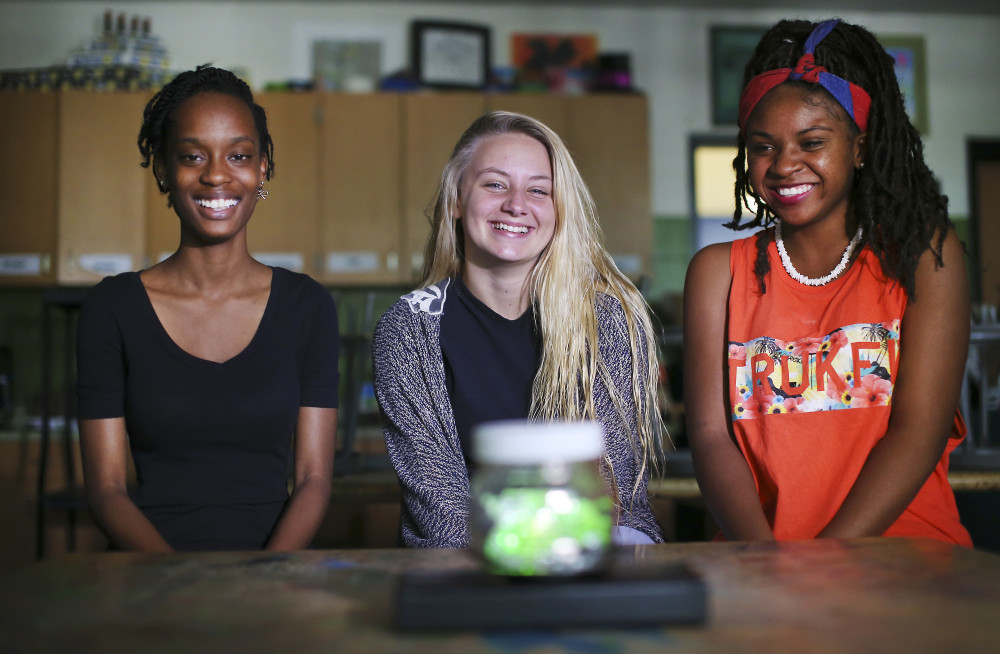By Kate Santich
Orlando Sentinel.
ORLANDO
There’s a place in Pine Hills, Fla., called the “Big Idea Lab,” where young minds are encouraged to let their imaginations run wild to solve some of world’s most vexing problems.
It’s where three teens have come up with a novel way to address illiteracy and the need for sustainable energy sources, an idea that could bring light to some of the most poverty-stricken corners of the Earth.
They’re using mushrooms that glow in the dark. The idea is that they could substitute for light in areas where electricity is spotty or non-existent.
“It could change children’s lives in Haiti,” says Rebecca Jean-Louis, who is 16 and half Haitian herself.
Rebecca and her friends, Mikayla Joseph and Deya Harrington, both 15, have already changed their own lives. At the Walt Disney World Boys & Girls Club, which runs the Idea Lab, the trio won the club’s nine-month after-school science challenge. For their reward, they were to leave for Cambridge, Mass., where they’ll consult with top professors, researchers and industry leaders at the international weeklong ArtScience Innovation Workshop, designed to nurture independent thinking. Only 14 teams from around the world earned the privilege.
“What’s great about the program is that it challenges the kids to think outside the box, to use all their powers of creativity in considering a solution,” says the club’s senior service director, Jose Bastias. “We want them to be visionary.”
Their journey began last fall, when the girls enrolled in the science challenge and dug into the esoteric world of bioluminescence: living organisms that naturally produce light. Such as fireflies.
“That’s what we were going to use at first,” says Mikayla. “But then we decided we didn’t want to harm any living creatures.”
Next they stumbled on the mushrooms. It turns out there are more than 70 species of bioluminescent fungi found in temperate and tropical climates, all of which emit a greenish light. If they could grow enough of the mushrooms in a small terrarium-shaped lamp, magnify the light with aluminum foil and devise a way to make it portable, perhaps, they theorized, they could generate enough light to allow someone to read or do simple chores after dark in places where sources of electricity are scarce, expensive and unreliable.
“My dad lives in Haiti, so I wanted to make something that would help there,” Mikayla says. “When he calls, he’ll tell me how sometimes the generator doesn’t work, and I know the electricity is bad.”
Besides, the girls will tell you, candles burn out. Kerosene is pricey and sometimes dangerous.
“The bad part is the mushrooms don’t live that long,” Deya explains. “But as they die, the spores are released, and the mushrooms regrow.”
Unless, of course, someone takes your diligently researched, potentially life-changing science project and tosses it out with the garbage.
Which is what happened.
In fairness to the janitorial staff at the Boys & Girls Club, the log, to the untrained eye, probably looked like it belonged in the trash.
“It takes about two months for the mushrooms to grow, and you’re supposed to leave them in a dark, damp area,” Rebecca says.
And, of course, the mushrooms, which they had ordered online for $50 a batch, had to grow on something. So there was a small, sort of dirty log involved. And the entire thing was wrapped in plastic. Each week, the girls would peek in on the mushrooms’ progress. The fungi had just begun to come into their own when one day the whole log went missing.
“I was pretty angry,” Mikayla says.
Alas, all great discoverers in history have their setbacks. With the final competition less than two months away, and so no time to grow a second batch of ‘shrooms, the girls decided to continue work on the terrarium/lamp and do their presentation with a battery-powered light subbing in.
“They were amazing,” says Nathaniel Palma, a Walt Disney World ambassador who represents the company at community and special events. He was one of the judges. “I was totally unaware that there was such a thing as these mushrooms. But it was actually a rather simple solution, a very feasible solution, that I would think could be implemented in a relatively short time.”
The mushrooms beat out pheromone-laden drones designed to lure snakes away from populated areas and extra-strength trash bags made from spider webs.
“They were all very impressive,” Palma says diplomatically.
That was late May. Since then, the three have continued to refine their prototype and research the mushrooms. In Cambridge, after all, there will be potential investors among the crowd, and who knows what might happen from there.
“We’ll start in Haiti,” Mikayla says. “And then if it goes well, we’ll expand the company.”














































































































































































































































































































































































